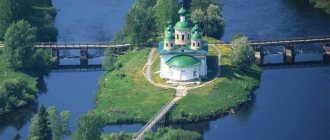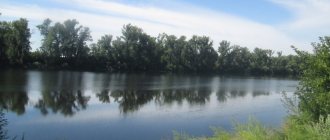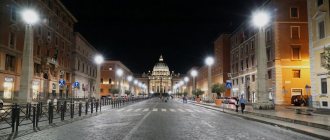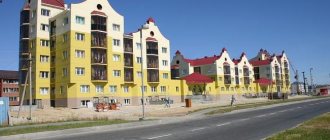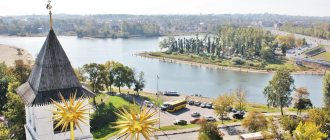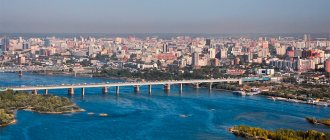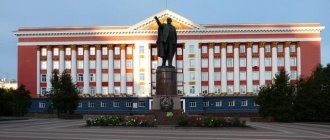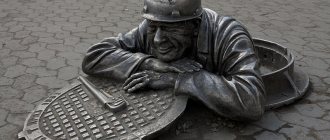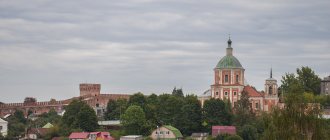The three dominant features of Smolensk are the longest fortress in Russia, three churches of the pre-Mongol era, and the stoic ordinariness with which local residents perceive these antiquities. They park cars without reverence at a 17th-century fortress, calmly take a shortcut through an ancient Catholic cemetery, play football on a field where the Kremlin wall serves as a fence, and 12th-century churches have been turned into part of an industrial landscape with railway tracks and a thermal power plant.
It’s convenient to come from Moscow one day to walk a six-kilometer victory lap along the fortress wall and take home a backpack of Smolensk sweets: figs, sweets and Vyazma gingerbread.
How to get there
There are four high-speed trains a day from Moscow to Smolensk. “Swallow” flies in 4 hours and costs 400–900 rubles. The schedule is great for a day trip. You leave Moscow at seven in the morning, and the return train from Smolensk is at seven in the evening. Eight hours is enough for your first acquaintance with the city.
If your schedule does not coincide with Lastochka, then 10–15 trains from Moscow to Belarus (or Kaliningrad) pass through Smolensk per day. From other regions of Russia, bypassing Moscow, you can get from Kazan, through the Ulyanovsk region. By Kazakh train via Chelyabinsk, Ufa, Samara and Tula. And by southern train from Adler through the Black Earth Region.
Towards Pskov and St. Petersburg and to the south to Bryansk it is more convenient and faster to get there by bus. I haven’t forgotten about the airport - there is none in the city of three hundred thousand.
Smolensk is a convenient point to stop for a day's walk on the way to Minsk or Brest. Day - we walk around Smolensk, night - we travel by train.
Administrative division of the city and demographic situation in Smolensk
According to Rosstat, 331 thousand people live in the territory of the regional center (data as of January 1, 2014). Most of them are women – 183 thousand. 79 thousand are people of retirement age, 208 thousand are the working population. Young people often leave Smolensk in search of work in Moscow and St. Petersburg.
Recently there has been a slight increase in the birth rate. As of January 1, 2014, 3,637 newborns were registered, which is 40 more babies than in the previous period.
The mortality rate is decreasing - by 152 people compared to 2013. However, the natural population decline of the city remains high – more than 700 people.
The situation on the labor market is relatively calm. According to the Smolensk City Employment Center, the unemployment rate at the end of 2014 was 0.64 percent. The labor market tension coefficient is 0.5. For every person who loses a job, there are two vacancies. Basically, these are blue-collar jobs with decent wages. The average monthly salary in Smolensk is 24 thousand rubles.
Smolyan residents live in three districts of the city - Leninsky (central district), Zadneprovsky and Promyshlenny (the largest district in terms of population and territory).
Where to sleep
The best (according to reviews on Booking.com) hotel in the city, West Hotel, is located on the outskirts of the city, surrounded by gas stations and car dealerships. For 1,700 ₽ you will get the service and design of a good chain hotel of the Ibis or Best Western level. Breakfast is better than the standardized buffet at the chain stores, and is more reminiscent of a hearty breakfast like grandma's. On the ground floor of the hotel there is Pyaterochka.
You can spend the night at the Aurora Hotel, which took 69th place in the list of “100 ugliest buildings in Russia” by urbanist Varlamov.
Budget travelers stay in Pichugin Hall or Travel hostels - 350–450 rubles per bed.
Extremely budget-minded or stubborn hikers can put up a tent on the banks of the Dnieper near the Dzerzhinsky Bridge. At this point on the maps.me maps there is a mark: “We spent the night with a tent on the grass.” At least two people checked the place for suitability for such an overnight stay.
Grand Duchy of Moscow: gathering lands
In the fight against the Tatars and neighbors, the Moscow princes did not forget about the “help” of the Lithuanians and the lands that “went to Lithuania.” As soon as Ivan III completed the unification of the north and east of Rus' and the Russian state had the strength for further expansion, Moscow remembered the “taken away Fatherland” - the Grand Dukes of Moscow had all the dynastic rights to these lands, and the feudal lords maneuvering between the Grand Dukes only added fuel to fire.
Under the first sovereign of all Rus', vast territories of the Verkhovsky principalities fell under the hand of Moscow - the triumphant “Vedrosh” war ended with the signing of a peace under which Lithuania lost a third of its territory, and the Moscow border was now dangerously close to Smolensk. This fortress became the next target of the Russian troops’ campaigns to the west.
What is Smolensk
Smolensk is one of those Russian cities that do not know how to talk about themselves - not to the world, but at least to Russia. What does a Russian know about Smolensk? “Somewhere near Belarus,” “the city was occupied by the Germans during the war,” and those who received straight A’s in history at school recalled that Smolensk was destroyed under Napoleon.
Surprisingly, Smolensk does not need to spend billions on restoring architectural monuments. Or invent and create points of attraction for tourists from scratch. Nature and ancestors have already done this for the Smolensk people.
It’s enough for them to preserve what they have, unconventionally “package” the product and tell the world about it. Ok, for starters - Russia.
Thanks to the unknown founder of the city for choosing the place and to nature for the hills. Staircases immersed in greenery, secret shortcuts from one street to another, private houses in ravines and majestic churches on hills - such views are impossible without relief.
There is a paradox at work in Russian realities: the poorer the city, the better the historical architecture is preserved. The center of Smolensk has not been spoiled by Soviet panels and modern “anthills”. Despite the eclecticism and mishmash of styles, the buildings fit together due to their proportionality to the person and there is no feeling of an urban jungle.
Monuments of Smolensk that are worth seeing
These historical monuments of Smolensk are especially popular among tourists:
- Resurrection Hill. This is the highest point in the city, although some mistakenly consider Cathedral Hill to be the highest point. Resurrection Hill is 7 m higher than it. On the hill stands the Resurrection Church. She's pretty small. For some time, the church housed a planetarium, but in 2012 it was moved to a building on Voikova Street, which is very nearby.
- Monument to A. T. Tvardovsky and Vasily Terkin. This landmark of Smolensk is located on Victory Square. The monument is quite colorful. The townspeople like to relax on the benches next to it.
- Monument "Scorched Flower". Erected in 2005 in memory of the children who were imprisoned in concentration camps during the war. All these terrible places are listed on the monument. Frost goes down your skin when you stand near him and are mentally transported to wartime with all its horrors.
- Foucault pendulum, located in the planetarium on Voikova Street. The Foucault pendulum demonstrates the daily rotation of the Earth and shoots up 12 m.
Wall Tour
A fact that Smolensk should flaunt, but which no one knows about: the Smolensk fortress wall is the longest in Rus' - six and a half kilometers along the perimeter. The fortress was built in 1602 for protection from the Poles. Initially it consisted of 38 towers. 18 towers and 9 fragments of a wall with a total length of 3 kilometers have survived to this day. It was not the Poles, not Napoleon, not the Germans who destroyed the fortress, but a banal shortage of building materials at the beginning of the 19th century, when part of the wall was dismantled into bricks. Not only is the heritage not appreciated today... In Soviet times, the fortress also suffered: it interfered with the large-scale restoration of the city, and several sections were demolished.
Each of the towers has a name: Avraamievskaya, Bubleyka, Veselukha, Volkova, Voronina, Gromovaya, Dnieper Gate, Dolgochevskaya, Donets, Zaaltarnaya, Zimbulka, Kopytenskaya, Kostyrevskaya, Mokhovaya, Nikolskaya, Orel, Pozdnyakova, Pyatnitskaya.
The best thing is that the wall is not museumized for tourists and is not surrounded by a fence. It is integrated into everyday life: pedestrians walk through it, roads are paved for cars. In one place there is a parking lot near the wall, in another part there is a hospital. Another part passes through the territory of the theological seminary, where you have to fight your way through unyielding guards who protect the peace of future priests. On Timiryazev there is a football field near the wall, and on Sobolev a Lukoil gas station is adjacent to the Kostyrevskaya tower of the early 19th century. The loopholes store old window frames, bricks and building materials that remained after the renovation of the hospital premises.
A walk along the perimeter of the wall is a minimum plan for Smolensk. The longest section begins from the Nikolskaya Tower. Near the Altar Tower there is a constructivist quarter and the Transfiguration Cathedral. You can climb the hills along the wall on Zagornaya Street. The 17th-century Bubleika Tower stands next to a 20th-century television tower. And the eastern section of the wall on Timiryazev is an unofficial observation deck.
Square of Memory of Heroes
Throughout history, many places have appeared in the city of Smolensk where residents could express their gratitude and respect to people who gave their lives for the peace and well-being of their fellow villagers. One of these places is the square near the Donets Tower, on the territory of which the heroes are buried. Among them is the legendary Mikhail Egorov, who, together with Kantaria, planted the Soviet flag over the Reichstag.
The Eternal Flame of Glory, busts of great commanders and a monument to the heroes of the war of 1812, which is called the “Monument with Eagles,” are also located there. It represents a nest guarded by two eagles. It looks symbolic and conveys the spirit of the Russian people.
Attractions
One of the symbols of modern Smolensk was the mongrel Polkan. In November 2022, the dog died suddenly. On social networks they blamed dog hunters, but at the autopsy they diagnosed a heart attack. The whole city knew the dog that ran around the center. Judging by the comments on social networks, many Smolensk residents, when leaving the house, grabbed goodies for Polkan. His death is a tragedy for them. All the city media and public pages wrote that the dog had died. And the initiative group is already collecting signatures to erect a monument to Polkan.
In addition to Polkan, the list of intangible heritage of Smolensk includes the freak musician Prophet Sunboy with the hit “I grew up as a boy in Smolensk”:
I grew up as a boy in Smolensk Ay-na-ne, na-ne, na-ne I know every corner here And at the collective farm market, at the village collective farm market Where they sell bucks and remember my every lesson I love its rye fields so much on Kiselevka And the haze blue in the early hour And the ringing of holy bells That heal the souls with Kirill, each of us Each of us, each of us Ay-na-ne, na-ne, na-ne I grew up as a boy in Smolensk Ay-na-ne, na- nah, nah-neh I can’t love Smolensk in any other way It seems to me that I will give everything to him And I run and ride my bicycle across the golden field To the Dnieper banks, to the Dnieper banks And the rye falls in pain at my feet The ancient city of Winter will soon drown in umbrellas will attribute an extra year to him, but he is still young and dear to everyone
Instead of restoring the cobblestone street on Tenisheva, it was rolled into asphalt. A piece of pavement measuring 1 m² was turned into an art object at the direction of the mayor. What the people of Smolensk and all the city media mocked. This is how the landmark-meme appeared - “Sovarenko Square”.
Another sad story about the architectural heritage is the House of Culture of the Society of the Deaf (Uritsky, 9), which, according to the ancient Pyaterochkin tradition, was disfigured with banners and extensions.
Smolensk is the only Russian city on the Dnieper - does anyone know about this? On both banks (not far from the modern bridge on Belyaeva Street) the remains of a century-old bridge have been preserved.
The main streets of the center are Belyaeva, Bolshaya Sovetskaya, Konenkova, Mayakovskogo and Lenin. The Smolensk pedestrian street on Lenin stretches only one block - from Bolshaya Sovetskaya to Konenkov.
The basis of the Lutheran community in Smolensk were Germans, some of whom fled after the 1917 revolution. It was then that the church was nationalized. After the start of the repressions in 1937, there were no Lutheran Germans left in the Smolensk region. The church building (Lenina, 12) has been a cinema, an editorial office, a house of pioneers and a puppet theater. Since the late seventies, the church has been occupied by a chess club.
The merchant's house on Belyaeva, 8, at first glance, does not stand out in any way. But if you know where to look, you will see a child’s statue on the façade. According to legend, the owner's little son drowned and the grief-stricken father immortalized the child on the facade of the house.
The Soviet mosaic has been preserved on the building of Smolensk State University (Przhevalsky, 4). In which the canonical trio: Engels, Marx and Lenin - turned into a duet - Engels disappeared somewhere.
In Smolensk they know how to adapt buildings that are not intended for housing. People live in pre-revolutionary barracks on the quiet, green streets of the Comintern town. The buildings of former prisons (Neverovsky, 1, Gagarina, 21) were converted into dormitories. Two former towers (Kommunisticheskaya, 6, Glinka, 2b) were turned into residential buildings.
Few people will pay attention to the standard Soviet monument in the park near the house on Kommunisticheskaya, 22. But behind the faceless figure hides the ideologist of Soviet repressions against dissidents - Nikolai Krylenko.
The typical building of the Soviet cinema "October" was occupied by a clothing fair. “What's so surprising about that? What we haven’t seen in Soviet recreation centers and cinemas.” But as soon as you go inside, you realize that you have entered, perhaps, the main attraction of Smolensk. The door to the cinema, like platform 9 ¾, transports those entering into another world. You just need to cross the threshold with confidence and knowledge that you are entering another world. Then you will see what the sellers and buyers who come to Oktyabr do not see. Surrounded by uplifting Soviet paintings with Komsomol members and builders on the ceilings, among pompous columns and stucco, heaps of Chinese clothes and people scurrying through the rows look as surreal and inappropriate as possible. Motivational films about Red Army soldiers and shock workers were supposed to be shown here, but capitalism won.
The “House of Youth” gallery is responsible for the sovrisk in Smolensk - the design of the halls and the choice of curators should please even the picky Moscow critic. No less interesting objects are exhibited in the Sergei Konenkov Sculpture Museum. The author worked most of his life in pre-revolutionary Russia, then in New York and in his old age returned to the Soviet Union. He actively participated in the 1905 revolution, but in the USA he attended a Protestant church. Such a diverse background left its mark on the sculptor’s work. In the museum, busts of Gorky and pioneer girls stand side by side with wooden pagan idols.
In the depths of the museum courtyard, closer to Bolshaya Sovetskaya, all Smolensk street art was concentrated - three large works.
Urbanists and designers will appreciate the stylish city infographics and racks of dog poop bags. And connoisseurs of unique details will not be able to help but notice the two-story sheds in Smolensk courtyards.
The Ferris wheel in the Lopatinsky Garden could not be launched. A public page appeared on VKontakte with the title “Have the Ferris wheel been launched in Smolensk?”, where for 89 days the answer “no” was posted on the wall every day. The wheel was launched on December 25.
Orthodoxy
In addition to the fortress wall and hills, dozens of churches form the image of Smolensk. Despite the wars and destruction that the city experienced, three pre-Mongol (mid-12th century) churches managed to survive in it.
Even if there was absolutely nothing else in Smolensk, just these churches would be enough to attract crowds of tourists. In Russia, more pre-Mongol churches - 13 - have survived only in Veliky Novgorod. In Vladimir there are three, as in Smolensk, and in Suzdal there is one.
But in terms of the number of tourists, the cities of the Golden Ring easily overtake Smolensk.
Three pre-Mongol churches:
- Michael the Archangel (Svirskaya),
- John the Evangelist on Varyazhki,
- Peter and Paul, which can be seen from the crossing near the railway station.
But still, it is not the pre-Mongol churches that are the main magnets for tourists. First of all, guests of Smolensk climb Cathedral Hill to see the monstrous Assumption Cathedral, stuffed with gold. It can be seen from anywhere in the city, and from it you can see the whole of Smolensk.
In addition, there are a dozen more old churches scattered around the center. On Belyaeva, 2a, there is a church of strange proportions. It’s as if a large temple was reduced by 3-4 times. The church premises are occupied by a shop with Orthodox goods. Smolensk is so religious that around the city you see stickers with quotes from the Bible: “The Lord looks at the heart,” “So, while we have time, let us do good to everyone,” and others. A fact no less important than the pre-Mongol churches is that Patriarch Kirill served as metropolitan in Smolensk for 25 years. “Kirill” from the song of the Prophet Sunboy is him.
Soviet architecture
In recent years, there has been a rethinking of Soviet architecture, and constructivism and modernism have gained many fans through Strelka and architectural publics. For fans of straight lines and rough concrete, we offer a route through the entire city.
- We start with the industrial building of the Smolensk Thermal Power Plant (Kashena, 10).
- The tower house of the Paris Commune (Konenkova, 13a) has been abandoned since the 80s, although it is an architectural monument. A place of attraction for informal people and introverted misanthropes who love abandoned places.
- The Regional Association of Trade Unions (Lenina, 13b) is one of the few brutalist buildings in the center.
- The House of Heroes of the Iron Stream (Kommunisticheskaya, 5) is a classic constructivist house with the letter P.
- State Bank (Bolshaya Sovetskaya, 41/48).
- Children's plant of the Belarusian Military District (Zapolny, 5a). Nearby there is a cozy Stalinist quarter (Herzen/Tvardovsky/Isakovsky/Chaplin) and a school with a bust of Felix Dzerzhinsky in the courtyard - they love security officers in Smolensk (Tvardovsky, 14).
- City Council Residential Building No. 8 (Gagarina 6) is a house that was built in the shape of the numbers 4 and 5, which symbolized the slogan “Five-Year Plan in Four Years.”
- Dzerzhinsky, 13 and 9 - two austere buildings next to elegant Art Nouveau and Stalinist Empire style.
- Hotel "Russia" (Dzerzhinskogo, 23/2) - spend the night there to soak in the atmosphere of the 80s.
The Stalinist Empire style, which is more understandable and beloved by Russians, is one of the main architectural markers of Smolensk. The city, destroyed after World War II, was built up and restored in the style that was popular before Stalin’s death.
Stroll through Gagarin with pompous Stalinism. The Smolensk Hotel (Glinki, 11), which is decorated with sculptures, was occupied by the House of the German Army during the occupation. Stalinka on Kommunisticheskaya, 22, is valuable not only for its architecture, but also for the shops on the ground floor that have preserved the spirit of the Soviet era - “Haberdashery”, “Knitwear”. It is better to look at the Spartak stadium (Dzerzhinsky, 18) from above - from the side of the fortress wall in the Lopatinsky Garden. On the treadmill you can easily imagine Soviet Komsomol athletes passing the GTO standards. An excellent location to cosplay as communist youth is an arch with bas-reliefs in the form of the Orders of Lenin and the Patriotic War (opposite the house on October Revolution, 4)
There are no services held in the Gothic Church of the Immaculate Conception (Pamfilova, 1) and people are not allowed inside. The temple is located in the forests, which gives hope for its restoration. Adhering to the side of the church is an old Catholic cemetery, through which local residents have trodden paths and take a shortcut from the house to the bus stop. The symbiosis of rickety crosses, hundred-year-old tombstones and Khrushchev buildings around and the ordinariness with which people perceive the cemetery inside the block is a characteristic feature of Smolensk, just like the everydayness of the fortress wall.
Unusual corners of Smolensk
- Museum "Smolensk Flax". Located on Tukhachevsky Street. The exhibitions tell about the history of flax processing, the emergence of the first loom. Its work is still shown today. The museum itself is located in the Nikolskaya Tower (Nikolsky Gate), which is also a historical monument of the city.
- House with a clock. Previously, this clock was located at the European Hotel, which was destroyed during the Second World War. According to legend, on the night of June 29, 1941, when the bombing began, they stopped. Caring townspeople hid the historical value. Then a residential building was built on this site, on which the surviving clock was installed.
- Bronze sculpture of a deer in the city garden "Blonje". The monument is notable for the fact that it was brought by the Red Army in 1945 from the estate of Kaiser Wilhelm.
- Museum of sculptures by S. T. Konenkov (XX century), which the author bequeathed to the city. Most of the exhibits are made of wood and leave a strong impression after viewing.
- Roman Catholic Church of the Immaculate Conception of the Blessed Virgin Mary. This is a red brick building in a classic Gothic style, striking in its grandeur.
War City
Smolyan residents are stuck in patriotic stereotypes - “shield city”, “shield of Russia”, “hero city”. Smolensk has indeed been affected by dozens of wars. First the Principality of Polotsk, then the Mongols, then Smolensk became part of the Principality of Lithuania and was already besieged by Russian troops. The Polish-Lithuanian Commonwealth took possession of the city in the 17th century. By the way, the Sheinov and Royal bastions in the Lopatinsky Garden were erected during the capture of the city by the Poles. A hundred years later, the city was burned by the retreating Napoleon. Until January 7, 1919, Smolensk was the capital of the Belarusian Soviet Socialist Republic. And in 1941–1943 the Germans ruled the city.
About 300 thousand people are buried within the boundaries of Smolensk. Urban defenders and urbanists are outraged that squares and streets are dotted with memorials and monuments. There have been no wars for 75 years, but the city continues to live with war memories.
The Smolensk Jewish ghetto existed for 11 months. On July 15, 1942, two thousand Jews were taken out of the city and shot. A memorial to the executed prisoners was erected on the site of the ghetto - in the private sector of the Trans-Dnieper region - Vyazovenka Street, Devichya Gora.
The monument to the victims of the Smolensk concentration camp No. 126 is located near Narvskaya, 11. The following is engraved on the memorial: “15 thousand Soviet citizens, brutally tortured by fascist executioners in 1941–1943, are buried here.” Nearby is a building that was allegedly used as a concentration camp crematorium. The memorial on Kozlova, 3, was erected in memory of the executed soldiers:
“The Germans first drove captured soldiers and commanders of the Red Army through Smolensk at night. In the city center they shot prisoners of war. All night long machine gun shots and heartbreaking cries for help were heard. For two kilometers along Sovetskaya Street and further on both sides of the road there were corpses with broken heads and disfigured faces...”
“From the Varangians to the Greeks”
It is believed that the city dates back to 863, but this is only the first dated mention - in the Ustyug list of the chronicle: the Novgorod boyars Askold and Dir were heading to Tsargorod along the Dnieper River, where they saw the settlement. “The city is great and there are many people...” - the chronicle reports. This means that the city is much older than its first “official” mention.
Smolensk connected the peoples of Scandinavia and the Black Sea region along the great trade route “From the Varangians to the Greeks.” This path ran not only along rivers and lakes, but also on land - the boats were dragged, often damaging the bottom. And in the ancient city they learned to tar boats and repair the clothes and shoes of travelers. This is where, according to the first Smolensk historian Nikifor Murzakevich, the name of the settlement came from: “Smolyans” - travelers nicknamed those who drove resin and traded in it. “Smolenets” - they called the settlement Smolyan.
A small digression from antiquity. The Smolyans (modern Vikings) were the first and only ones in the world to travel the entire ancient route from the Varangians to the Greeks. The expedition of the Smolensk club “Viking-Nevo” lasted a quarter of a century and ended in 2014. At certain stages of the expedition, Scandinavians - Swedes and Finns - joined the Smolensk people.
The expedition began on the boat "Dir", which today is installed at the entrance to the Naval Museum named after Admiral Nakhimov. The Askold boat is stored on the site of one of the first travelers. The Smolensk residents completed the expedition on an exact copy of an ancient boat, built with their own hands according to the drawings of a Swedish shipbuilder and traveler.
Let's continue the historical path. According to a number of serious researchers and historians, the ancient settlement was located lower along the Dnieper than the modern city, where archaeologists found the ancient Gnezdovo mounds during the construction of the Moscow-Warsaw railway in the mid-19th century. More than 4 thousand mounds, one and a half thousand preserved burials with jewelry, weapons, and household items - a truly unique archaeological discovery!
Excavations are still ongoing here with sensational finds. And the burial ground itself is the largest necropolis in eastern and northern Europe.
In the country
- Memorial complex "Katyn" at the site of mass executions of Polish prisoners of war and prisoners of Stalin's prisons and camps. From the center of Smolensk minibus 30N goes to the Gnezdovo microdistrict. Get off on the highway without entering the microdistrict, and walk two kilometers in the direction of travel - towards Belarus.
- "Hitler's Bunker" and the German military cemetery in Krasny Bor, 8 kilometers from Smolensk.
- The Monument to the Executed Roma in Aleksandrovka is the only memorial to the victims of the Roma genocide during World War II.
- A memorial sign at the site of the plane that crashed in 2010 near the Smolensk-Severny airport, in which Polish President Lech Kaczynski was flying (Kutuzova, 15b).
The Grand Duchy of Lithuania: to whom the Horde, and to whom the mother is dear
Batya's invasion became a death sentence for Kievan Rus. The fragmented principalities in the east fell under the yoke of the Horde. The Western principalities were included in more powerful and consolidated entities - Lithuania and Poland.
Seversky and Verkhovsky (located in the upper reaches of the Dnieper) lands, Smolensk, Kyiv, Podolia, Volyn - all of them became part of the Grand Duchy of Lithuania, which spread within the borders of modern Lithuania, Belarus and most of Ukraine. For the inhabitants of these lands, the Lithuanian princes were the ones who saved them from the yoke and feudal tyranny.
Grand Dukes Vasily III and Sigismund the Old. Source: wikipedia.com
The annexation of the Russian principalities significantly strengthened Lithuania - by the middle of the 15th century, the area of the grand duchy was almost 1 million square meters. km. The overwhelming majority of this territory was inhabited by a Russian Orthodox population. The conclusion of a personal union between Poland and Lithuania, the gradual strengthening of Polish and Catholic influence in the lands subject to Vilna changed the situation in the country, where the majority of the population, who professed Orthodoxy, slowly but surely began to have their rights infringed.
From liberators from the Horde yoke, the Lithuanian princes began to turn into tramplers of faith. At the same time, in the east, the process of uniting the fragmented principalities into a single Russian state began. The Lithuanian princes well understood how dangerous their neighbor in the east was and sought to prevent the formation of the Eastern Russian principality, because Lithuania itself claimed the right to become the center of the unification of the lands of Kievan Rus.
Food
The Beryozka dining room (Kozlova, 3a) looks unprepossessing, but the food there is delicious, which confirms the lack of empty seats at lunch. The student canteen (Kommunisticheskaya, 21) is the cheapest place in the city, where lunch costs 120 ₽: solyanka - 28 ₽, pork cutlet - 52 ₽, vegetable stew - 25 ₽, dried fruit compote - 15 ₽. The menu clarifies that peklevanny bread is a term from the 18th–19th centuries, which means finely ground flour, most often rye. At the Bufet cafe (Przhevalskogo, 2), a business lunch costs a little more - 150 ₽ (soup, hot dog/burger and tea), and falafel will cost 160 ₽. At the Khlebnaya Manufactory bakery (11 locations in the city), you can buy artisan bread and have a snack of hot pastries with coffee. Bar "Mayakovsky" (Mayakovsky, 3) - blues, jazz and business lunch for 150-250 rubles with two slices of bread, which is emphasized in the menu. Have a non-trivial and leisurely meal at the “Claws and Tails” rack (Gagarina, 8). The main specialty is crayfish, 1600 ₽/kg. For coffee, go to Coffeebook (October Revolution, 6, and two other cafes) or Anderson (Przhevalsky, 6/25).
Significant dates in the history of Smolensk
- 863 - first mention in chronicles.
- 882 – annexation to Kievan Rus.
- 1127 – birth of the Smolensk Principality.
- 1239 – invasion of the Mongol-Tatars. During the battles, the city was completely destroyed for the first time.
- 1514 – liberation of the city from the power of the Lithuanians.
- 1595–1602 - construction of the Smolensk fortress.
- 1654 – liberation from the oppression of the Polish-Lithuanian Commonwealth.
- 1706 – Peter the Great visited the city and assigned the status of a province.
- 1890 – opening of the first water pipeline.
- 1901 - the appearance of electricity in the city.
- 1943 – liberation from the fascist invaders.
- 1966 - the city was awarded the Order of the Patriotic War, first degree.
- 1983 – Smolensk was awarded the Order of Lenin.
- 1985 – Smolensk was awarded the title “Hero City”.
- 1973 – opening of CHPP-2.
Entertainment
"A-club" is responsible for guitar music. His playbill includes both AC/DC tribute bands and Kis-Kisa solo albums. The Gubernsky club (it is already 15 years old) also shows flexibility in organizing events: evenings for schoolchildren until 22:00 and retro parties for respectable gentlemen and ladies. Those who are between them in age flex at Nigative concerts.
As part of the “Place: Smolensk” project, concerts and theatrical performances are held in the workshop of a former shoe factory, abandoned houses and on the streets of Smolensk - an application for revitalization. This year their performance was longlisted for the Golden Mask theater award.
Design space "Sreda" - lectures, film screenings, master classes and the most fashionable parties for those over 20.
The creative space and coffee shop “Stab” (Zhukova, 9) is a concentration of grassroots initiatives for those over 30: plays, book presentations, film screenings and, of course, lectures. Every day something happens. In addition, there is a mini stand with souvenirs, food and coffee.
Siege artillery is the key to cities
Among the Grand Duke's arguments in the fight against the fortress walls was the extensive artillery park created under Ivan III. Russian artillery was one of the most advanced in Europe, although the era of heavy artillery was just beginning - its great connoisseur was the Burgundian Duke Charles the Bold, after whose death his work was continued by Charles VII of France, who received part of the Burgundian arsenals at his disposal. During the king's campaign in Italy, the walls of medieval cities collapsed under a hail of French cannonballs, which gave impetus to the development of new ideas in fortification.
Cannonmaking was a strategic industry in the 16th century, comparable to modern nuclear forces, because only a powerful and independent state could afford the full cycle of production, maintenance and operation of heavy guns. The effect of bombards and mortars throwing 250-kilogram cannonballs was no less than that of explosions at the Bikini Atoll or the Semipalatinsk test site.
During the campaign of the Lithuanian prince Vitovt against Novgorod, one shot from a super-powerful bombard was enough to persuade not only the besieged fortress of Porkhov, but also Veliky Novgorod itself to negotiate. The Russians paid an impressive ransom of 11 thousand rubles and recognized Vytautas’ victory - and all at the cost of one shot. It is curious that for the mentioned gun the shot turned out to be fatal: the gun was torn apart along with its creator and servants. It is unlikely that the prince grieved greatly for the killed gunner, but he appreciated the effectiveness of the artillery.
Popular message topics
- The works of Ivan Shmelev
Ivan Sergeevich Shmelev (1873-1950) is a famous Russian writer. The leitmotif of his work is love for the Russian people and nostalgia for life in the Motherland before the revolution. Complex and rich life - Cinema The art of
cinema arose in the 19th century thanks to the Lumière brothers. Famous Frenchmen were able to “revive” photographs and provide people with a new type of entertainment. Film art can be divided into the following types: artistic, - Catfish (species, habitat, what they eat)
Catfish is the largest fish that inhabits modern bodies of water. This is both river and lake fish. Catfish belongs to the ray-finned class of fish. The fish itself looks very powerful, that is, it has quite impressive strength and size.
